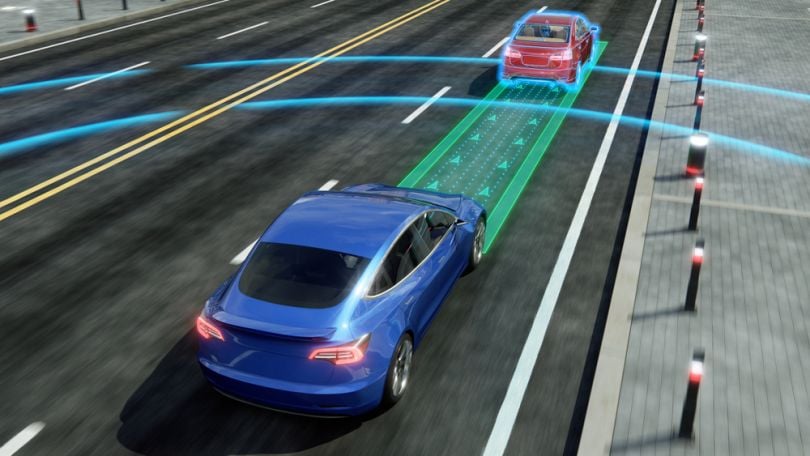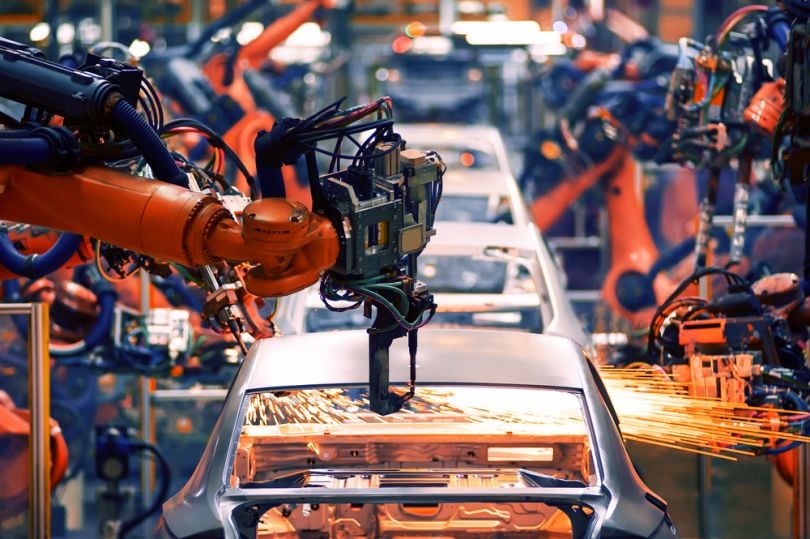Artificial intelligence and self-driving cars are often complementary topics in technology. Simply put, you cannot really discuss one without the other.
Though AI is being implemented at rapid speed in a variety of sectors, the way it’s being used in the automotive industry is a hot-button issue.
Artificial Intelligence in the Automotive Industry
With every car manufacturer and their mother racing to develop artificial intelligence and self-driving technologies, there are also a slew of tech companies and startups with the same purpose.
Though many believe personal, autonomous vehicles are the future, there are multiple ways in which AI and machine learning are being implemented in how vehicles are built and how they operate on the road. AI in cars aims to improve vehicle safety, increase fuel efficiency and provide drivers with enhanced connectivity features.
Check out how these companies are using artificial intelligence in cars.

AI for Autonomous Vehicles
Let’s start with the elephant in the room: self-driving vehicles.
Many major auto manufacturers are working to create their own autonomous cars and driving features, but we’re going to focus on relatively young tech companies and startups that have formed out of the idea of self-driving vehicles.
Whether their technology is for use in public transportation, ride sharing or personal needs, the following companies are at the forefront of autonomous vehicle technology.
Location: Aurora, Ontario
How it’s using AI in cars: Magna International is a mobility tech company and auto supplier that’s bringing artificial intelligence to their manufacturing and autonomous driving systems. The company says AI will play a major role as autonomous vehicles hit the road, especially when it comes to object detection and classification that help vehicles identify weather conditions, traffic volume and speed limits. The company also leverages AI in the manufacturing process to provide human operators with detailed information that can improve their decision making throughout production, and uses AI-enabled predictive maintenance systems to reduce down-time in manufacturing.
Location: Santa Monica, California
How it’s using AI in cars: Motional is a joint effort between Aptiv and the Hyundai motor group, each combining its technical expertise with real-world experience to design autonomous driving technology that pushes the potential of self-driving cars into reality.
The company’s autonomous driving technology utilizes three sensor types — LiDAR, radar and cameras — to prioritize safety at all times, leading to the world’s first robotaxi pilot and an operational commercial robotaxi service that has provided over 100,000 self-driven rides with a record of zero at-fault incidents. Since 2018, Motional has teamed up with major rideshare organizations Lyft, Via and Cox Automotive to increase the accessibility of self-driven transportation throughout the world.
Location: Mountain View, California
How it’s using AI in cars: Beginning as Google’s exploration of self-driving vehicles, Waymo is now its own company creating driverless vehicles that can safely deliver people from points A to B.
With over 20 million autonomous miles driven to date, Waymo’s 360-degree perception technology detects pedestrians, other vehicles, cyclists, road work and other obstacles from up to 300 yards away.
Location: Foster City, California
How it’s using AI in cars: While some companies are outfitting existing vehicles with self-driving capabilities, Zoox is creating its own autonomous vehicles from scratch.
The cars are being produced to be robotic rideshare vehicles. Similar to current transportation services like Uber or Lyft, a user would summon a Zoox vehicle for a ride through an app on their smartphone. In 2023, Zoox conducted its first robotaxi ride with passengers on a public road.
Location: San Jose, California
How it’s using AI in cars: AutoX makes retail-based autonomous vehicles, working on fleets for robotaxi and driverless grocery delivery services.
The company’s vehicles combine AI software, sensors, real-time cameras and thousands of test miles, both virtual and real, to ensure safe decisions on the road. AutoX has been deploying its robotaxi services in China and also received a permit to launch a robotaxi pilot program in California.
Location: San Francisco, California
How it uses AI in cars: Cruise, a subsidiary of General Motors, makes self-driving cars. It uses large sets of data to operate these driverless cars, including data on road layouts, location, traffic patterns, vehicle performance and rider preference and behavior. The company relies on AI to analyze and utilize this data, turning it into insights that can be acted on automatically.

AI for Auto Manufacturing
With over 85 million cars produced globally in 2022, it’s no wonder manufacturers are seeking out machinery and ways to enhance production.
Artificial intelligence in the automotive industry is not only changing the cars on the road, but the factories that build them and the processes for repairing them.
Here are a few examples of how smart machinery and AI-powered systems are making automotive production lines more efficient.
Location: Detroit, Michigan
How it’s using AI in cars: General Motors designs, manufactures and sells consumer cars and trucks. It has brought AI into its production lines, where predictive analytics assess performance history and detect potential issues, and into its vehicles themselves, where AI algorithms provide intelligent route planning to reduce “range anxiety” in EV drivers and conversational AI powers OnStar virtual assistance.
Location: Chicago, Illinois
How it’s using AI in cars: CCC enables the automotive and insurance industries to make better decisions through digital transformation driven by AI, IoT and workflow solutions.
The company connects auto manufacturers to a data pipeline that unlocks actionable insights from insurers and repair facilities while also connecting them to a network of over 26,000 repair facilities nationwide, facilitating visibility into how to make vehicles safer and more durable.
Location: Milwaukee, Wisconsin
How it’s using AI in cars: Rockwell Automation equips its manufacturing robots with AI to assist the car production process. These robots can fully assemble cars, apply paint and install intricate parts. The company also offers AI-powered solutions for manufacturing tires and producing electric vehicles.
Location: Fully Remote
How it’s using AI in cars: ABB offers a host of robotic AI products across many industries, but its manufacturing robots are an interesting example of AI in cars. The company’s cobots work alongside humans to inspect vehicle parts, paint and more. The cobots use AI technology to sense the presence of people and objects and learn when to stop moving.

AI for Driver Assistance
If you’re lucky enough to have a new car that can parallel park itself, then you’re in possession of a vehicle utilizing an AI-powered advanced driver-assistance system.
There are many different types of ADAS like automatic braking, driver drowsiness detection and lane departure warning. Some systems go beyond those already implemented in many major vehicle brands, with companies using them to re-train their commercial drivers and avoid collisions within their fleets.
Here’s how a few companies are using artificial intelligence in cars for driver-assisted technologies to make the roads safer.
Location: Fully Remote
How it’s using AI in cars: Motive builds hardware and software products that businesses use to manage their vehicle fleets. The company’s solutions include AI-powered features meant to help customers improve productivity and safety. For example, Motive’s AI Dashcam is designed to cut down on accidents by identifying unsafe driving behaviors like following another vehicle too closely and offering drivers real-time alerts.
Location: Santa Cruz, California
How it’s using AI in cars: SapientX produces white-label software that adds conversational voice and intelligence capabilities to tech products throughout industries like automotive, video conferencing, health and air travel.
The company has been working to implement natural conversational AI within vehicles, utilizing speech recognition, natural language processing, speech synthesis and smart avatars to boost comprehension of context, emotion, complex sentences and user preferences. SapientX’s AI systems are capable of running both online and offline while avoiding the need for customers to have to learn commands beyond a wake word, leading to more usable AI.
Location: San Francisco, California
How it’s using AI in cars: CarVi makes an ADAS that can be used for personal vehicles, fleets, ride-sharing or auto insurance companies.
CarVi uses AI to provide driving analysis and real-time alerts to warn drivers of possible dangers like lane departure, forward collisions and driving conditions. CarVi also uses a scoring system to rate driving skills and help drivers alter bad behaviors and habits. CarVi can be installed in existing vehicles and helps fleet companies track their vehicles, receive reports on vehicle performance, provide dashcam footage of events and cut their insurance premiums with overall safer drivers.
Location: Palo Alto, California
How it’s using AI in cars: Nauto creates AI sensor technology for commercial fleets.
Nauto’s intelligent driver system reduces distracted driving that leads to collisions by assessing driver behavior. The system uses data to keep drivers attentive enough to avoid collisions and traffic violations. With video and facial recognition, Nauto even helps companies process claims with insurance carriers more efficiently.
Location: Palo Alto, California
How it’s using AI in cars: Tesla produces electric cars equipped with Autopilot, the company’s ADAS that enables automatic steering, accelerating, braking, lane changing and parking. Tesla says its technology is “intended for use with a fully attentive driver, who has their hands on the wheel and is prepared to take over at any moment.”

AI for Autonomous Delivery
Takeout and grocery delivery services have been growing in popularity, with consumers expecting their goods to arrive faster and more efficiently. The online food delivery services industry is projected to reach a market value of more than $192 billion by 2025.
Artificial intelligence has been creeping its way into the field, enabling self-driving vehicles to fulfill delivery orders. Here are three examples of autonomous delivery services making use of AI in cars.
Location: Ann Arbor, Michigan
How it’s using AI in cars: Refraction AI manufactures a robotic, self-driving delivery solution for last mile goods from places like restaurants, pharmacies and grocery stores, facilitating faster, cheaper and safer delivery that keeps up with customer expectations.
The company’s flagship vehicle, named REV-1, is designed to operate in all weather conditions and has a size and weight that makes it versatile enough to switch between car and bike lanes to prioritize delivery time without impeding traffic. Along with powerful AI that allows REV-1 to choose the best possible path for making a delivery, low-cost sensor technology like cameras are utilized to allow the vehicle to stop on a dime — leading to a safe, compact and scalable solution to autonomous delivery.
Location: San Francisco, California
How it’s using AI in cars: Starship Technologies builds self-driving delivery robots. They move at pedestrian speeds as they navigate around obstacles, carrying packages, groceries and meals to customers who placed orders via the Starship app.
Weighing less than 100 pounds, the company’s autonomous delivery robots have a cargo bay that remains locked until it reaches the customer, who can use the app to unlock the compartment and retrieve their order. Starship’s robots have completed more than 4 million deliveries, according to its website.
Location: Berkeley, California
How it’s using AI in cars: Kiwibot is developing a robotic last-mile delivery network, featuring a fleet of more than 500 AI-powered, all-electric robots. They have been deployed on 26 campuses throughout the United States. Users can place restaurant orders through an app and then track their robotic delivery in real-time.
Other Uses of AI in the Auto Industry
Location: Atlanta, Georgia
How it’s using AI in cars: Cox Enterprises is the parent company for Cox Automotive, which operates a variety of brands focused on developing innovative solutions to support automotive retail. Cox incorporates AI into its car shopping solutions, offering a product called Esntial Commerce, for example, which is a web-based platform that enables automated online financing.



















